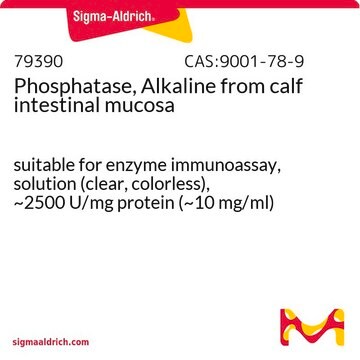APMB-RO
Roche
Alkaline Phosphatase
solution, from bovine (calf) intestine, 2 units/μg protein, optimum pH 7.5-9.5
Synonym(s):
ALP, CAP, CIAP, calf intestinal phosphatase, cip, orthophosphoric monoester phosphohydrolase
About This Item
Recommended Products
biological source
bovine (calf) intestine
Quality Level
form
solution
specific activity
2 units/μg protein
packaging
pkg of 1,000 U (10713023001 [1 U/μl])
pkg of 1,000 U (11097075001 [20 U/μl])
manufacturer/tradename
Roche
parameter
37 °C optimum reaction temp.
optimum pH
7.5-9.5
shipped in
wet ice
storage temp.
2-8°C
Related Categories
General description
Application
Note: The 11097075001 preparation has a high concentration of enzyme (20 U/μl), which is convenient for large-scale experiments. The 10713023001 preparation is a lower concentration (1 U/μl), which is convenient for small-scale experiments.
Sequence
Unit Definition
Note: According to Moessner et al. 5 units alkaline phosphatase (+37 °C; diethanolamine buffer) correspond to 1 unit alkaline phosphatase (+25 °C; glycine/NaOH buffer).
Unit Conversion: Approx. 3.6 U (MB grade AP)
[+37 °C, 4-NPP as substrate, diethanolamine as buffer, pH 9.8] = 1 U [+25 °C, 4.NPP as substrate, glycine as buffer, pH 10.5].
Volume Activity: 20 U/μl for the 11097075001 preparation. 1 U/μl for the 10713023001 preparation.
Physical form
11097075001: Enzyme solution (20 U/μl) in storage buffer, pH 7.6 (20 °C)
Preparation Note
Storage conditions (working solution): Dilutions (1 to 5 U/μl) of MB grade AP in the storage buffer are stable for 17 months at 2 to 8 °C.
Higher Dilutions (~0.01 U/μl) should be made fresh daily and kept at 2 to 8 °C.
Preventing self-ligation of vectors during cloning
If a linearized vector lacks a 5′ phosphate, it cannot ligate to itself or form concatamers that contain multiple copies of the vector. Thus, the product of the ligation reaction is predominantly recombinant DNA (vector + DNA insert), rather than religated plasmid.
Inactivation: Add 1/10 volume of EGTA to the reaction mix and incubate at +65°C for 10 minutes. To ensure complete inactivation of enzyme, extract the mix with phenol/chloroform/isoamyl alcohol to remove all protein.
Other Notes
Storage Class Code
12 - Non Combustible Liquids
WGK
WGK 1
Flash Point(F)
does not flash
Flash Point(C)
does not flash
Certificates of Analysis (COA)
Search for Certificates of Analysis (COA) by entering the products Lot/Batch Number. Lot and Batch Numbers can be found on a product’s label following the words ‘Lot’ or ‘Batch’.
Already Own This Product?
Find documentation for the products that you have recently purchased in the Document Library.
Customers Also Viewed
Our team of scientists has experience in all areas of research including Life Science, Material Science, Chemical Synthesis, Chromatography, Analytical and many others.
Contact Technical Service






